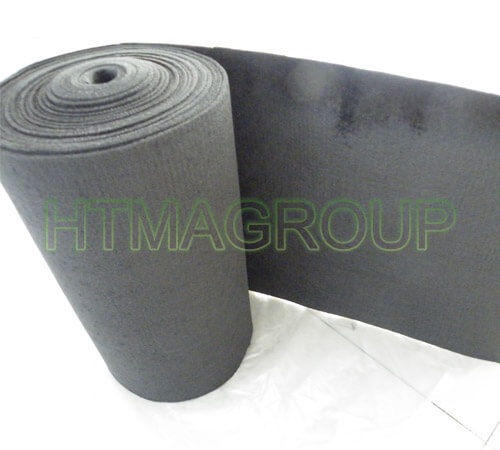The high strength, superior stiffness, the light weight of carbon fibers have made them the dominant reinforcing fibers used in high-performance polymer matrix composites. However, the same fibers can also reinforce brittle materials, such as ceramics and carbon, thus creating a unique class of high-temperature composite materials. When properly protected from oxidation, these carbon fiber-carbon matrix composites can withstand extended exposure to temperatures of up to 2500C, making them attractive for many aerospace applications. In addition, because of their improved friction performance and high wear resistance, carbon-carbon materials are used in high-performance brakes of aircraft and racing cars. Using these CC brakes in passenger cars and trucks is currently being evaluated.

pan based graphite felt
At present, all commercial carbon fibers are produced by the thermal decomposition of various organic fiber precursors. The most popular precursor materials are fibers of polyacrylonitrile (PAN), cellulos (Rayon), and pitch. A proposed alternate process, which produces a discontinuous, high-performance carbon fiber, is called vapor-growth. The chapter describes the similarities of these four fiber processes and discusses their differences.
Manufacture of PAN-based carbon fibers:
Today, approximately 90% of all the commercial carbon fibers are produced from a PAN precursor fiber. Normally, Pan is copolymerized with a small amount of another monomer, such as methylacrylate, to lower its glass transition temperature and control its oxidation rate. Figure 1 lists a few of the many monomers copolymerized with acrylonitrile to produce commercial PAN precursor fibers. Typically, the precursor fiber would contain 93-95 present acrylonitrile units, with the remainder being one or more of these monomers. Because PAN docomposes below its melt temperature, it is normally extruded into filament from using various solution spinning techniques.
Solution spinning of PAN precursor fibers;
Melt-assisted spinning of PAN precursor fibers;
Oxidation of PAN precursor fibers;
Carbonization and graphitization process;
Both the final heat treatment and the degree of molecular orientation of the molecules in the thermoset precursor fiber govern the modulus of the final carbon fiber product. As in all brittle materials, structural flaws limit the strength of the final carbon fiber. Thus, the purity in the precursor fiber, the final carbonization conditions, and even the void content of the precursor fiber can influence the strength of the final carbon fiber.
After final heat treatment, most PAN-based carbon fibers are given a surface treatment to improve their bonding with polymeric matrix materials. Although surface treatment results in some roughening of the surface, its primary effect is to increase the concentration of oxygenated groups on the fiber surface. Various techniques can accomplish this: exposing the carbon fiber to gases (such as air or carbon dioxide) at elevated temperature, submerging the fiber in sodium hypochlorite or nitric acid solutions, or electrolytically etching the fiber. The principal goal of thie process step is to increase the interfacial bond strength between the fiber and the matrix material and, thus, improve the interlaminar shear strength of the composite.
After being surface-treated, a small amount of size is added to improve the wettability of the carbon fiber, Normally, this size is a low molycular weight from of the anticipated matrix polymer. In other words, epoxy-sized fiber is coated with a low molycular weight expoxy. It should be mentioned that the primary objective of this size is to improve the wettability of the fiber, not to improve its handleability. Therefore, even sized fibers can be difficult to handle during perform weaving and composite fabrication.
related news /articles:
Properties and Applications of Graphite felt–CFCCARBON LTD
Carbonization and Graphitization of carbon fibers
Carbon fiber reinforced silicon carbide composites (C/SiC, C/C-SiC)-(1)
Introduction of carbon carbon composite, CFC, Carbon composite, C/C,